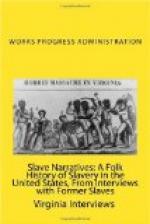With the memories of the Civil War still fresh in her mind and and secret longing to return to her Old Kentucky Home, Mrs. Anna Smith, born in May of 1833 and better known to her friends as “Grandma” Smith, is spending her remaining days with her grandchildren, in a pleasant home at 518 Bishop Street.
On a plantation owned by Judge Toll, on the banks of the Ohio River at Henderson, Ke., Anna (Toll) Smith was born. From her own story, and information gathered from other sources the year 1835 is as near a correct date as possible to obtain.
Anna Smith’s parents were William Clarke and Miranda Toll. Her father was a slave belonging to Judge Toll. It was common practice for slaves to assume the last name of their owners.
It was before war was declared between the north and south that she was married, for she claims her daughter was “going on three” when President Lincoln freed the slaves. Mrs. Smith remembers her father who died at the age of 117 years.
Her oldest brother was 50 when he joined the confederate army. Three other brothers were sent to the front. One was an ambulance attendant, one belonged to the cavalry, one an orderly seargeant and the other joined the infantry. All were killed in action. Anna Smith’s husband later joined the war and was reported killed.
When she became old enough for service she was taken into the “Big House” of her master, where she served as kitchen helper, cook and later as nurse, taking care of her mistress’ second child.
She learned her A.B.C.’s by listening to the tutor teaching the children of Judge Toll.
“Grandma” Smith’s vision is the wonder of her friends. She has never worn glasses and can distinguish objects and people at a distance as readily as at close range. She occupies her time by hooking rag rugs and doing housework and cooking. She is “on the go” most of the time, but when need for rest overtakes her, she resorts to her easy chair, a pipeful of tobacco and a short nap and she is ready to carry on.
Many instances during those terrible war days are fresh in her mind: men and boys, in pairs and groups passing the “big house” on their way to the recruiting station on the public square, later going back in squads and companies to fight; Yankee soldiers raiding the plantation, taking corn and hay or whatever could be used by the northern army; and continual apprehension for the menfolk at the front.
She remembers the baying of blood hounds at night along the Ohio River, trying to follow the scent of escaping negroes and the crack of firearms as white people, employed by the plantation owners attempted to halt the negroes in their efforts to cross the Ohio River into Ohio or to join the Federal army.
Referring to her early life, she recalls no special outstanding events. Her treatment from her master and mistress was pleasant, always receiving plenty of food and clothing but never any money.




